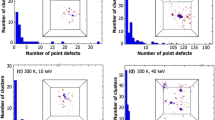Abstract
In this paper, we describe the computer simulation technique and its application to the study of radiation damage. Details of two important methods: the static and the dynamic methods have been discussed. Applications to the study of point defect formation and stability, their clusters, diffusion, dislocations and dislocation-point defect interaction are discussed drawing from our own work wherever possible. A short mention is made of the importance of the interatomic potential. Examples for the case of magnesium and other hcp metals, bcc iron and fcc Ni are cited and numbers for various quantities like formation energy, dipole tensor, interaction energy etc are quoted.
Similar content being viewed by others
References
Baskes M I and Melius C F 1979Phys. Rev. B20 3197
Beeler J R Jr 1966Phys. Rev. 150 470
Beeler J R Jr 1983aRadiation effects computer experiments (Amsterdam: North-Holland)
Beeler J R Jr 1983bRadiation effects computer experiments (Amsterdam: North-Holland) p. 318
Beeler J R Jr 1983cRadiation effects computer experiments (Amsterdam: North-Holland) p. 428
Beeler J R Jr and Johnson R A 1967Phys. Rev. 156 677
Cotterill R M J and Doyama M 1967 inLattice defects and their interactions (ed.) R R Hasiguti (New York: Gordon and Breach) p. 20
Erginsoy C, Vineyard G H and Englert A 1964Phys. Rev. A133 595
Gibson J B, Goland A N, Milgrom M and Vineyard G H 1960Phys. Rev. 120 1229
Hoagland R G, Hirth J P and Gehlen P C 1976Philos. Mag. 34 413
Johnson R A 1973J. Phys. F3 295
Lucasson P 1975 inFundamental aspects of radiation in metals (eds) M T Robinson and F W Young (US Department of Commerce, National Technical Information Service, Springfield, USA, Report Conf. 751006) Vol. 1, p. 42
Perrin R C, Englert A and Bullough R 1972 inInteratomic potentials and simulation of lattice defects (eds.) P C Gehlen, J R Beeler Jr. and R I Jaffee (New York: Plenum Press) p. 509
Puls M P 1980 inProc. Int. Conf. on Dislocation Modelling of Physical Systems, (ed) C S Hartley (UK: Pergamon Press)Special Acta Met./Scripta Met. Publication
Purniah B, Srinivasan S and Krishan K 1980 inProc. Nucl. Phys. and Sol. State Phys. Symposium, Delhi (Department of Atomic Energy) Vol. C23, p. 742
Purniah B, Srinivasan S and Krishan K 1982 inPoint defects and defect interactions in metals Proc. Int. Conf., (eds) J Takamura, M Doyama and M Kiritani (Tokyo: Univ. of Tokyo Press) p. 322
Purniah B and Srinivasan S 1986Bull. Mater. Sci. 8 247
Sahu H K, Srinivasan S and Krishnan K 1980Pramana (J. Phys.) 15 189
Silsbee R H 1957J. Appl. Phys. 28 1246
Wilson W D, Baskes M I and Bisson C L 1976Phys. Rev. B13 2470
Author information
Authors and Affiliations
Rights and permissions
About this article
Cite this article
Krishan, K., Purniah, B. & Srinivasan, S. Computer simulation of defects and radiation damage. Bull. Mater. Sci. 8, 155–167 (1986). https://doi.org/10.1007/BF02744180
Issue Date:
DOI: https://doi.org/10.1007/BF02744180




